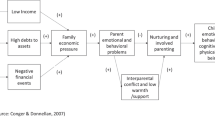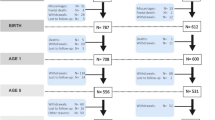Abstract
The purpose of the present research is to explore the association between socioeconomic status (SES), daily internet use (DIU), birth order (BO), family size (FS), maternal working hours (MWH), and paternal working hours (PWH) with theory of mind (ToM) skills among pre-schoolers and primary schoolers. A total of 177 pre-school children and primary school children were included in the research sample. The research was designed as correlational research. The data were analysed with multiple linear regression analysis. Results of the research showed that DIU and SES are most negatively associated with ToM of the participant children. Moreover, it was observed that BO and FS are negatively related to ToM and PWH has higher correlation than MWH in the context of ToM. It was concluded that higher SES seems to offer more availability of internet and digital technologies in home settings and this availability causes negative associations between SES and ToM. Findings were discussed along the relevant literature.
Similar content being viewed by others
Data availability
Based on informed consent from the participant children and their parents, they were ensured that the data would not be shared with any other third parties. Therefore, there is no data availability to protect their privacy.
References
Andreassen CS, Billieux J, Griffiths MD, Kuss DJ, Demetrovics Z, Mazzoni E, Pallesen S (2016) The relationship between addictive use of social media and video games and symptoms of psychiatric disorders: a large-scale cross-sectional study. Psychol Addict Behav 30(2):252–262
Astington JW, Jenkins JM (1995) Theory of mind development and social understanding. Cogn Emot 9(2–3):151–165
Atkin AJ, Sharp SJ, Corder K, van Sluijs EM (2014) Prevalence and correlates of screen time in youth: an international perspective. Am J Prev Med 47(6):803–807
Barr AB (2015) Family socioeconomic status, family health, and changes in students’ math achievement across high school: a mediational model. Soc Sci Med 140:27–34
Barr N, Pennycook G, Stolz JA, Fugelsang JA (2015) The brain in your pocket: evidence that smartphones are used to supplant thinking. Comput Hum Behav 48:473–480
Beeres D, Andersson F, Vossen HG, Galanti MR (2021) Social media and mental health among early adolescents. J Adolesc Health 68(5):953–960
Bowerman BL, O’Connell RT (1990) Linear statistical models: an applied approach. Duxbury, Belmont, CA
Bradley RH, Corwyn RF (2002) Socioeconomic status and child development. Ann Rev Psychol 53(1):371–399
Brito NH, Noble KG (2014) Socioeconomic status and structural brain development. Front Neurosci 8:276
Bond TG, Fox CM (2015) Applying the rasch model: fundamental measurement in the human sciences. Routledge, New York
Carpendale JIM, Lewis C (2006) How children develop social understanding. Blackwell, Oxford, UK
Charness G, List JA, Rustichini A, Samek A, Van De Ven J (2019) Theory of mind among disadvantaged children: evidence from a field experiment. J Econ Behav Organ 166:174–194
Christensen JF (2017) Pleasure junkies all around! Why it matters and why ‘the arts’ might be the answer: a biopsychological perspective. Proc R Soc B Biol Sci 284(1854):20162837
Cole K, Mitchell P (1998) Family background in relation to deceptive ability and understanding of the mind. Soc Dev 7(2):181–197
Crowley K (2014) Child development. Sage Publications, London
Cutting AL, Dunn J (1999) Theory of mind, emotion understanding, language, and family background: individual differences and interrelations. Child Dev 70(4):853–865
Devine RT, Hughes C (2018) Family correlates of false belief understanding in early childhood: a meta-analysis. Child Dev 89(3):971–987
Duncan OD, Featherman DL, Duncan B (1972) Socio-economic background and achievement. Seminar Press, New Yok
Ebert S, Peterson C, Slaughter V, Weinert S (2017) Links among parents’ mental state language, family socioeconomic status, and preschoolers’ theory of mind development. Cogn Dev 44:32–48
Farah MJ (2018) Socioeconomic status and the brain: prospects for neuroscience-informed policy. Nat Rev Neurosci 19(7):428–438
Field A (2012) Discovering statistics using R. Sage Publications, London
Gentile DA, Swing EL, Lim CG, Khoo A (2012) Video game playing, attention problems, and impulsiveness: evidence of bidirectional causality. Psychol Pop Media Cult 1(1):62–70
Goldstein TR, Winner E (2012) Enhancing empathy and theory of mind. J Cogn Dev 13(1):19–37
Goswami U (2014) Child psychology: short introduction. Oxford University Press, London
Hackman DA, Farah MJ (2009) Socioeconomic status and the developing brain. Trends Cogn Sci 13(2):65–73
Hackman DA, Gallop R, Evans GW, Farah MJ (2015) Socioeconomic status and executive function: developmental trajectories and mediation. Dev Sci 18(5):686–702
Hair JF, Black B, Babin BJ, Anderson RE (2010) Multivariate data analysis. Pearson, New York
Hart B, Risley TR (2003) The early catastrophe: the 30 million word gap by age 3. Am Educ 27(1):4–9
Heath SB (1972) Children’s language. State Department of Education, Columbia, SC
Hollingshead AB (1965) Two-factor index of social position. Yale University Press, New Haven
Hou XH, Gong ZQ, Wang LJ, Zhou Y, Su Y (2020) A reciprocal and dynamic development model for the effects of siblings on children’s theory of mind. Front Psychol 11:2667
Huber B, Yeates M, Meyer D, Fleckhammer L, Kaufman J (2018) The effects of screen media content on young children’s executive functioning. J Exp Child Psychol 170:72–85
Hughes C, Devine RT, Wang Z (2018) Does parental mind-mindedness account for cross-cultural differences in preschoolers’ theory of mind? Child Dev 89(4):1296–1310
Imuta K, Henry JD, Slaughter V, Selcuk B, Ruffman T (2016) Theory of mind and prosocial behavior in childhood: a meta- analytic review. Dev Psychol 52(8):1192
Jenkins JM, Astington JW (1996) Cognitive factors and family structure associated with theory of mind development in young children. Dev Psychol 32(1):70
Jones DE, Greenberg M, Crowley M (2015) Early social-emotional functioning and public health: the relationship between kindergarten social competence and future wellness. Am J Public Health 105(11):2283–2290
Korkmaz B (2011) Theory of mind and neurodevelopmental disorders of childhood. Pediatr Res 69(8):101–108
LaBounty J, Wellman HM, Olson S, Lagattuta K, Liu D (2008) Mothers’ and fathers’ use of internal state talk with their young children. Soc Dev 17(4):757–775
Leblanc É, Bernier A, Howe N (2017) The more the merrier? Sibling composition and early manifestations of theory of mind in toddlers. J Cogn Dev 18(3):375–391
Lin F, Zhou Y, Du Y, Qin L, Zhao Z, Xu J, Lei H (2012) Abnormal white matter integrity in adolescents with internet addiction disorder: a tract-based spatial statistics study. PloS One 7(1):e30253
Liu M, Wu L, Yao S (2016) Dose–response association of screen time-based sedentary behaviour in children and adolescents and depression: a meta-analysis of observational studies. Br J Sports Med 50(20):1252–1258
McMahon CA, Bernier A (2017) Twenty years of research on parental mind-mindedness: empirical findings, theoretical and methodological challenges, and new directions. Dev Rev 46:54–80
Meins E (1997) Security of attachment and the social development of cognition. Psychology Press, Sussex
Myers R (1990) Classical and modern regression with applications. PWS- Kent, Boston, MA
National Institute of Child Health and Human Development, Early Child Care Research Network (2003) Early child care and motherñchild interaction from 36 months through first grade. Infant Behav Dev 26:345–370
National Institute of Child Health and Human Development, Early Child Care Research Network (2006) Infant-mother attachment classification: risk and protection in relation to changing maternal care- giving quality. Dev Psychol 42(1):38–58
Nelson K (2004) Toward a collaborative community of minds. Behav Brain Sci 27(1):119–120
Nikkelen SW, Valkenburg PM, Huizinga M, Bushman BJ (2014) Media use and ADHD-related behaviors in children and adolescents: a meta-analysis. Dev Psychol 50(9):22–28
Orben A, Przybylski AK (2019) Screens, teens, and psychological well-being: evidence from three time-use-diary studies. Psychol Sci 30(5):682–696
Pea R, Nass C, Meheula L, Rance M, Kumar A, Bamford H, Nass M, Simha A, Stillerman B, Yang S, Zhou M (2012) Media use, face-to-face communication, media multitasking, and social well-being among 8- to 12-year-old girls. Dev Psychol 48(2):327–336
Pears KC, Moses LJ (2003) Demographics, parenting, and theory of mind in preschool children. Soc Dev 12(1):1–20
Perner J (1991) Learning, development, and conceptual change In: Understanding the representational mind. The MIT Press, Cambridge
Perner J, Ruffman T, Leekam SR (1994) Theory of mind is contagious: you catch it from your sibs. Child Dev 65(4):1228–1238
Peterson C, Slaughter V (2003) Opening windows into the mind: mothers’ preferences for mental state explanations and children’s theory of mind. Cogn Dev 18(3):399–429
Pornari CD, Wood J (2010) Peer and cyber aggression in secondary school students: the role of moral disengagement, hostile attribution bias, and outcome expectancies. Aggress Behav 36(2):81–94
Ruffman T (2014) To belief or not belief: Children’s theory of mind. Developmental Review 3(4):265–293
Ruffman T, Perner J, Naito M, Parkin L, Clements WA (1998) Older (but not younger) siblings facilitate false belief understanding. Dev Psychol 34(1):161–174
Ruffman T, Slade L, Crowe E (2002) The relation between children’s and mothers’ mental state language and theory-of-mind understanding. Child Dev 73(3):734–751
Ruffman T, Slade L, Devitt K, Crowe E (2006) What mothers say and what they do: the relation between parenting, theory of mind, language and conflict/cooperation. Br J Dev Psychol 24(1):105–124
Schaafsma SM, Pfaff DW, Spunt RP, Adolphs R (2015) Deconstructing and reconstructing theory of mind. Trends Cogn Sci 19(2):65–72
Selcuk B, Brink KA, Ekerim M, Wellman HM (2018) Sequence of theory-of-mind acquisition in Turkish children from diverse social backgrounds. Infant Child Dev 27(4):e2098
Shatz M, Diesendruck G, Martinez-Beck I, Akar D (2003) The influence of language and socioeconomic status on children’s understanding of false belief. Dev Psychol 39(4):717
Sirin SR (2005) Socioeconomic status and academic achievement: a meta-analytic review of research. Rev Educ Res 75(3):417–453
Sodian B (2005) Theory of mind: the case for conceptual development. In: Schneider W, Schumann-Hengsteler R, Sodian B (Eds.) Young children’s cognitive development: interrelationships among executive functioning, working memory, verbal ability and theory of mind. Lawrence Erlbaum Associates, Mahwah, NJ, pp 95–130
Thayer JD (2002) Stepwise regression as an exploratory data analysis procedure. In: Paper presented at the annual meeting of the American Educational Research Association (April 1–5), New Orleans
Twenge JM, Martin GN, Campbell WK (2018) Decreases in psychological well-being among American adolescents after 2012 and links to screen time during the rise of smartphone technology. Emotion 18(6):765–780
Wellman HM, Cross D, Watson J (2001) Meta-analysis of theory-of-mind development: the truth about false belief. Child Dev 72(3):655–684
Woods HC, Scott H (2016) # Sleepyteens: social media use in adolescence is associated with poor sleep quality, anxiety, depression and low self-esteem. J Adolesc 51:41–49
Wu XS, Zhang ZH, Zhao F, Wang WJ, Li YF, Bi L, Quian Z, Lu SS, Feng F, Hu CY, Gong FF, Sun HY (2016) Prevalence of internet addiction and its association with social support and other related factors among adolescents in China. J Adolesc 52:103–111
Funding
There is no funding to conduct the research.
Author information
Authors and Affiliations
Contributions
KC prepared analyzed the data prepared the research report. Dr. CK and MC collected the data.
Corresponding author
Ethics declarations
Ethical approval
We certify that the study was performed in accordance with the ethical standards as laid down in the 1964 Declaration of Helsinki and its later amendments or comparable ethical standards. The scale and methodology for this study was approved by the Human Research Ethics committee of the Artvin Coruh University (18457941-050.99-68783).
Informed consent
All participant children and their parents were informed and consent to participate in the study. Its process was well detailed in the method section.
Competing interests
There is no competing interests among the authors.
Rights and permissions
Springer Nature or its licensor (e.g. a society or other partner) holds exclusive rights to this article under a publishing agreement with the author(s) or other rightsholder(s); author self-archiving of the accepted manuscript version of this article is solely governed by the terms of such publishing agreement and applicable law.
About this article
Cite this article
Coşkun, K., Kara, C. & Coskun, M. Is socio-economic status a priviledge anymore? A new explanation of this question. SN Soc Sci 4, 101 (2024). https://doi.org/10.1007/s43545-024-00902-z
Received:
Accepted:
Published:
DOI: https://doi.org/10.1007/s43545-024-00902-z




